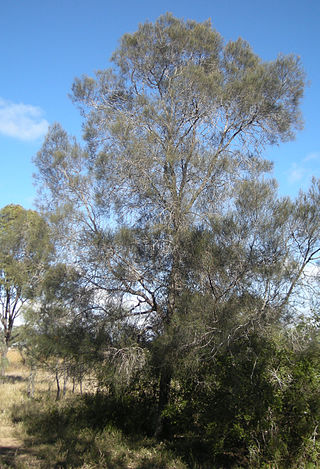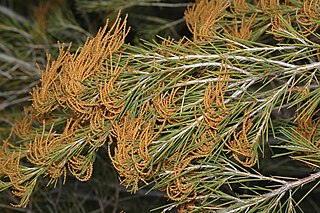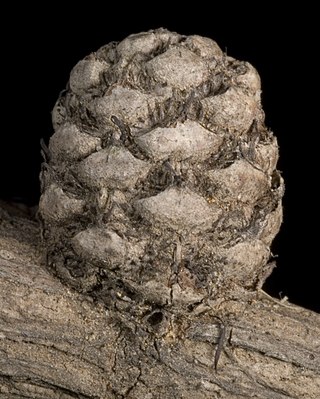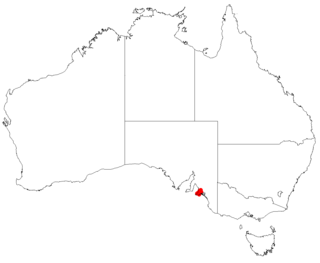
Allocasuarina, commonly known as sheoak or she-oak, is a genus of flowering plants in the family Casuarinaceae and is endemic to Australia. Plants in the genus Allocasuarina are trees or shrubs with soft, pendulous, green branchlets, the leaves reduced to scale-like teeth. Allocasuarinas are either monoecious or dioecious, the flowers never bisexual. Male and female flowers are arranged in spikes, the female spikes developing into cone-like structures enclosing winged seeds.

Allocasuarina huegeliana, commonly known as rock sheoak is a species of flowering plant in the family Casuarinaceae and is endemic to Western Australia. It is a dioecious tree that has its leaves reduced to scales in whorls of eight to ten, the mature fruiting cones 14–35 mm (0.55–1.38 in) long containing winged seeds (samaras) 5–7 mm (0.20–0.28 in) long.

Allocasuarina lehmanniana, commonly known as dune sheoak, is a species of flowering plant in the family Casuarinaceae and is endemic to near-coastal areas of the south-west of Western Australia. It is dioecious or less commonly a monoecious shrub that has its leaves reduced to scales in whorls of six to eight, the mature fruiting cones 12–35 mm (0.47–1.38 in) long containing winged seeds (samaras) 4.0–5.5 mm (0.16–0.22 in) long.

Allocasuarina torulosa, commonly known as forest oak, rose sheoak, river oak or Baker's oak, is a species of flowering plant in the family Casuarinaceae and is endemic to eastern Australia. It is a slender, usually dioecious tree that has drooping branchlets up to 140 mm (5.5 in) long, the leaves reduced to scales in whorls of four or five, and the fruiting cones 15–33 mm (0.6–1 in) long containing winged seeds (samaras) 7–10 mm (0.3–0.4 in) long.

Allocasuarina humilis, commonly known as dwarf sheoak, is a species of flowering plant in the family Casuarinaceae and is endemic to the south-west of Western Australia. It is an erect or spreading dioecious or monoecious shrub that has its leaves reduced to scales in whorls of five to seven, the mature fruiting cones 12–22 mm (0.47–0.87 in) long containing winged seeds (samaras) 5–6 mm (0.20–0.24 in) long.

Allocasuarina distyla, commonly known as scrub she-oak, is a species of flowering plant in the family Casuarinaceae and is endemic to south-eastern New South Wales. It is a dioecious shrub that has branchlets up to 350 mm (14 in) long, the leaves reduced to scales in whorls of six to eight, the fruiting cones 13–35 mm (0.51–1.38 in) long containing winged seeds (samaras) 4.0–8.0 mm (0.16–0.31 in) long.

Allocasuarina luehmannii, commonly known as buloke or bull-oak, is a species of flowering plant in the family Casuarinaceae and is endemic to south-eastern continental Australia. It is a dioecious tree, that has its leaves reduced to scales in whorls of ten to fourteen, and the mature fruiting cones are 5–12 mm (0.2–0.5 in) long containing winged seeds (samaras) 4–5 mm (0.16–0.20 in) long.

Allocasuarina decaisneana, commonly known as desert oak, desert sheoak, or kurkara by the Anangu peoples, is a species of flowering plant in the family Casuarinaceae and is endemic to Central Australia. It is a dioecious tree that typically grows to a height of 10–16 m (33–52 ft) and has long, drooping branchlets, the leaves reduced to scales in whorls of four, the mature fruiting cones 28–95 mm (1.1–3.7 in) long containing winged seeds (samaras) 8.5–17 mm (0.3–0.7 in) long.

Allocasuarina verticillata, commonly known as drooping sheoak, is a species of flowering plant in the family Casuarinaceae and is endemic to south-eastern Australia. It is a small dioecious tree that has drooping branchlets up to 400 mm (16 in) long, the leaves reduced to scales in whorls of nine to thirteen, the mature fruiting cones 20–50 mm (0.8–2 in) long containing winged seeds (samaras) 7–12 mm (0.3–0.5 in) long.

Allocasuarina inophloia, commonly known as stringybark she-oak, is a species of flowering plant in the family Casuarinaceae and is endemic to eastern Australia. It is a small dioecious tree that has finely fibrous, ribbony bark, its leaves reduced to scales in whorls of seven to nine, the mature fruiting cones 10–20 mm (0.4–0.8 in) long containing winged seeds (samaras) 5–6 mm (0.20–0.24 in) long.

Allocasuarina acuaria is a species of flowering plant in the family Casuarinaceae and is endemic to the southwest of Western Australia. It is a dioecious shrub that has erect branchlets, the leaves reduced to scales in whorls of four on the ends of the branchlets, the fruiting cones 15–19 mm (0.59–0.75 in) long containing winged seeds (samaras) about 6 mm (0.24 in) long.

Allocasuarina acutivalvis is a species of flowering plant in the family Casuarinaceae and is endemic to the southwest of Western Australia. It is a dioecious shrub to small tree that has erect branchlets, the leaves reduced to scales in whorls of 10 to 14, the fruiting cones 15–35 mm (0.59–1.38 in) long containing winged seeds (samaras) 6–12 mm (0.24–0.47 in) long.

Allocasuarina drummondiana is a species of flowering plant in the family Casuarinaceae and is endemic to the south-west of Western Australia. It is an intricately branched, dioecious shrub that has its leaves reduced to scales in whorls of six or seven, the mature fruiting cones 8–15 mm (0.31–0.59 in) long containing winged seeds (samaras) 3–4 mm (0.12–0.16 in) long.

Allocasuarina grevilleoides is a species of flowering plant in the family Casuarinaceae and is endemic to the south-west of Western Australia. It is a small, spreading, dioecious shrub that forms a lignotuber, and has more or less erect, sharply-pointed branchlets, the leaves reduced to scales in whorls of four, the mature fruiting cones 9–14 mm (0.35–0.55 in) long containing winged seeds (samaras) 5.5–7.0 mm (0.22–0.28 in) long.

Allocasuarina ramosissima is a species of flowering plant in the family Casuarinaceae and is endemic to the south-west of Western Australia. It is a dioecious shrub with its leaves reduced to overlapping scales in whorls of five, the mature fruiting cones sessile and 9–13 mm (0.35–0.51 in) long, containing winged seeds 4.5–5.0 mm (0.18–0.20 in) long.

Allocasuarina scleroclada is a species of flowering plant in the family Casuarinaceae and is endemic to areas along the south coast of Western Australia. It is a straggly, dioecious shrub that has branchlets up to 230 mm (9.1 in) long, the leaves reduced to scales in whorls of ten or eleven, the mature fruiting cones 18–25 mm (0.71–0.98 in) long containing winged seeds 5–8 mm (0.20–0.31 in) long.
Allocasuarina tessellata is a species of flowering plant in the family Casuarinaceae and is endemic to the south-west of Western Australia. It is a dioecious shrub or tree that has more or less erect branchlets, the leaves reduced to scales in whorls of eight or nine, the mature fruiting cones 26–55 mm (1.0–2.2 in) long containing winged seeds 5.0–7.5 mm (0.20–0.30 in) long.

Allocasuarina trichodon is a species of flowering plant in the family Casuarinaceae and is endemic to areas along the south coast of Western Australia. It is a dioecious, rarely a monoecious shrub that has branchlets up to 300 mm (12 in) long, the leaves reduced to scales in whorls of eight to ten, and the fruiting cones 15–50 mm (0.59–1.97 in) long containing winged seeds 8–10 mm (0.31–0.39 in) long.

Allocasuarina monilifera, commonly known as necklace sheoak, is a species of flowering plant in the family Casuarinaceae and is endemic to Tasmania. It is usually a monoecious, low-growing shrub that has branchlets up to 150 mm (5.9 in) long, the leaves reduced to scales in whorls of six to nine, the fruiting cones 15–30 mm (0.59–1.18 in) long containing winged seeds 5–6 mm (0.20–0.24 in) long.

Allocasuarina robusta, commonly known as Mount Compass oak-bush, is a species of flowering plant in the family Casuarinaceae and is endemic to a restricted area of South Australia. It is a monoecious, rarely a dioecious shrub with erect branchlets up to 200 mm (7.9 in) long, the leaves reduced to scales in whorls of five to seven, the fruiting cones 12–20 mm (0.47–0.79 in) long containing winged seeds about 5.5–6.0 mm (0.22–0.24 in) long.























